Life and achievements
Early life
Douglas Engelbart was born in Portland, Oregon, on January 25, 1925. He was a child during the Great Depression, which significantly impacted his beliefs about social justice and the need to change the world. Engelbart attended Franklin High School and later joined the Oregon State University, where he took an engineering course in electrical engineering. His academic year was cut short by the Second World War, in which he joined the U.S. Navy, serving as a radar technician in the Philippines. This gave him an insight into the strength of technology, and he first came across the concept of computing through the article As We May Think by Vannevar Bush. Thus, Bush's vision of the global interconnection with access to information inspired Engelbart and his further projects.
After returning from the war, Engelbart continued his studies and graduated with a bachelor's degree in electrical engineering in 1948. He then joined the NASA Ames Research Center and later proceeded to the University of California Berkeley, where he obtained his master's and Ph.D. in electrical engineering. Engelbart was initially involved in research on digital computing and high-frequency electronics; however, his area of interest was understanding how computing could enhance human thought processes and decision-making.
This desire to use technology for societal improvement led Engelbart to join the Stanford Research Institute (SRI) in 1957 to found the Augmentation Research Center. His ideas about increasing group wisdom with interactive computing developed there, and many concepts that define today's computing originated from that place.
Legacy
Douglas Engelbart's contribution is enormous due to his invention of the computer mouse and his idea of how technology can enhance human performance. His 1968 presentation, "The Mother of All Demos," was a significant step in advancing computing. He introduced video teleconferencing, text editing, and sharing tools. Engelbart's ideas were way before his time because he did not only envision technology but how technology could help humanity address its most challenging problems through collective problem-solving and increased intelligence.
Engelbart's work, however, remained obscure for many years but has now been credited as pioneering in human-computer interaction, hypertext, and computer-supported cooperative work. His ideas of networked computing that allowed people to interact in real-time regardless of their geographical location were prophetic in creating the internet and the www. The notion of 'bootstrapping' that he introduced — the use of tools and processes to enhance the creation of further tools and processes — has applications in areas as diverse as software engineering and business administration.
Today, Engelbart's work is carried on by the Doug Engelbart Institute, which is dedicated to the development of "Collective IQ," which implies an increase in the overall intelligence and effectiveness of people working on particular problems to achieve growth in the rate of the solution of global issues. His work is not limited to technology but encompasses education, management, and social systems. He has been rightfully called a visionary whose ideas still define the world of tomorrow.
Milestone moments
Mar 11, 1962
Publication of "Augmenting Human Intellect: The paper aims to present "A Conceptual Framework."
In 1962, Engelbart published a seminal report titled Augmenting Human Intellect: A Conceptual Framework. He described his ideas about how computers could augment human intelligence in this document.
Engelbart claimed that technology could enhance the problem-solving capability of individuals and groups by improving their handling of information.
This report enabled Engelbart to secure funding from ARPA, now known as DARPA, and set up the Augmentation Research Center at SRI.
In the paper, he outlined some ideas that would define his future work, such as interactive computing and hypertext and the concept of augmenting human intellect.
Augmenting human intelligence became the theoretical pillar for human-computer interaction.
Dec 9, 1968
The Mother of All Demos
Engelbart demonstrated the concept on December 9, 1968, at the Fall Joint Computer Conference in San Francisco, now dubbed the Mother of All Demos.
In this 90-minute demonstration, Engelbart presented the world with the computer mouse, hypertext, real-time text editing, video conference, and collaborative computing.
The groundbreaking demo demonstrated that computers were not just for calculations but communication, coordination, and information sharing.
Most of the technologies that Engelbart showed years back in the 1960s were futuristic and are today's essential technologies in computing.
Aug 12, 1970
A Brief History of the Invention of the Computer Mouse
It was in 1970 that Engelbart applied for a U.S. Patent and got the patent number 3,541,541 for the computer mouse.
His design, which was created with the assistance of his team at SRI, involved a wooden casing with two metal rollers.
This 'X-Y position indicator' enabled users to place a cursor on the screen, thus changing the way people interact with computers.
While Engelbart never got a dime from the mouse's sales, it became one of the most widely used pointing devices in computing that significantly impacted the creation of GUI, which is still in use today.
It could be said that the invention of the mouse is one of Engelbart's most significant achievements in the sphere of technology.
May 23, 1988
Bootstrap Institute was established.
In 1988, Engelbart and his daughter Christina established the Bootstrap Institute, later renamed the Doug Engelbart Institute.
It was founded as a non-profit organization to further Engelbart's idea of collective intelligence and to carry on the development of enhanced man-computer interfaces.
With the help of the Bootstrap Institute, Engelbart gave seminars and workshops to develop augmenting human intellect further.
The institute also provided the means for researchers, technologists, and organizations to connect, which would also allow for the idea of Engelbart of technology as problem-solving for the many to continue to permeate the next generations.
